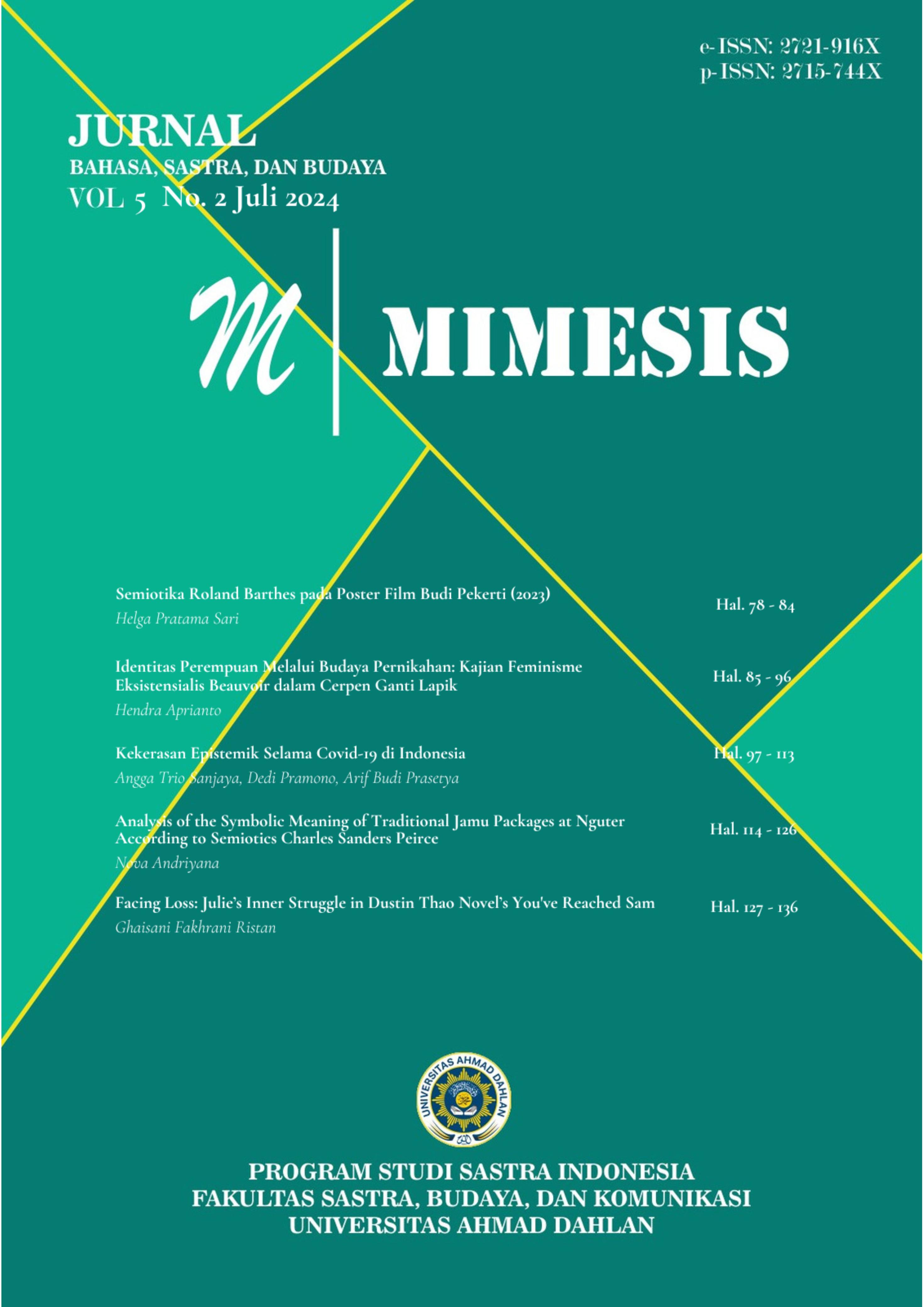Facing Loss: Julie's Inner Struggle in Dustin Thao Novel’s You've Reached Sam
DOI:
https://doi.org/10.12928/mms.v5i2.11248Keywords:
Kurt Lewin, Main Character, Novels, The Inner ConflictAbstract
The inner conflict experienced by the character Julie in the novel You've Reached Sam by Dustin Thao and the way Julie's character overcomes inner conflict is interesting to study with the theory proposed by Kurt Lewin.This study aims to examine the inner conflict experienced by the main character in the novel You've reached Sam by Dustin Thao, along with the factors that affect the occurrence of these conflicts using a literary psychology approach. This research is a qualitative descriptive research with primary sources in the form of phrases, words, or sentences quoted in the novel You've reached Sam and secondary sources are used in the form of reference books, and national and international journal articles. The data collection technique is carried out by reading and recording data in the form of inner conflicts and the factors that affect them. The analysis technique in this study refers to the three stages of the triangulation technique. This research found that Juliet's character experiences an inner conflict that is in accordance with Kurt Lewin's formula are approach-approach conflict; avoidance-avoidance conflict; and approach-avoidance conflict. The dominant factors that affect the occurrence of inner conflicts are psychological pressure (driving forces) and tensions.
References
Adelman, C. (1993). Kurt Lewin and the origins of action research. Educational Action Research, 1(1), 7–24.
Alfi, M., Nasution, I., & Harahap, N. (2024). Konflik batin tokoh utama dalam novel Kiara karya Dinni Adhiawaty: Kajian psikologi sastra. Jurnal Bahasa Indonesia Prima (BIP), 6(1), 103–112.
Apriyani, T., & Nalurita, B. A. Y. (2023). Nilai kebangsaan pada karya-karya Leila S. Chudori. Diglosia, 6(2), 375–388.
Burnes, B. (2020). The origins of Lewin’s three-step model of change. The Journal of Applied Behavioral Science, 56(1), 32–59.
Fachrudin, A. Y. (2020). Konflik batin tokoh Sari dalam novel Perempuan Bersampur Merah karya Intan Andaru (Kajian Psikologi Sastra Kurt Lewin). Bapala, 7(1), 1–9.
Hikmawati, V., Suntoko, & Pratiwi, W. D. (2021). Konflik batin tokoh utama dalam novel Pertanyaan Kepada Kenangan karya Faisal Oddang (Tinjauan Psikologi Sastra). Jurnal Onoma: Pendidikan, Bahasa, Dan Sastra, 7(2), 663–676. https://e-journal.my.id/onoma
Lestari, D., Trisfayani, & Mahsa, M. (2023). Konflik batin tokoh utama dalam novel Rindu karya Tere Liye (Pendekatan Psikologi Sastra). KANDE: Jurnal Ilmiah Pendidikan Bahasa Dan Sastra Indonesia, 4(1), 101–114.
Lestari, F. A., & Sugiarti, S. (2023). Konflik batin pada tokoh utama dalam novel Rasa karya Tere Liye: Analisis psikologi sastra. Sintesis, 17(2), 142–155. https://doi.org/10.24071/sin.v17i2.5689
Lewin, K., & Cartwright, D. (1951). Field theory in social science: Selected theoretical papers. Harper.
Miles, M., Huberman, M., & Saldana, J. (2019). Qualitative data analysis; a methods sourcebook (4th ed.). SAGE Publication. https://a.co/d/1TodHDn
Novika, N. A. D., Kiftiawati, & Nugroho, B. A. (2023). Konflik batin tokoh utama dalam novel Aku, Meps, dan Beps karya Soca Sobhita dan Reda Gaudiamo kajian psikoanalisis Kurt Lewin. Ilmu Budaya, 7(2), 741–750.
Nurbaya, Nur, Y., & Lembah, G. (2020). Konflik batin tokoh utama novel Tanpa Kata karya Endry Boeriswati: Pendekatan Konflik Kurt Lewin. Jurnal Kreatif Online, 8(1).
Nurgiyantoro, B. (2017). Teori pengkajian fiksi. UGM Press.
Nurhaya, D., & Indarti, T. (2022). Poligami dalam novel Dua Barista karya Najhaty Sharma (Kajian psikologi sastra Kurt Lewin). Bapala, 9(3), 82–90.
Prikusuma, A. R., & Pamungkas, O. Y. (2024). Konflik batin tokoh Ibu dalam Novel Ibuku (Tidak) Gila karya Anggie D. Widowati: Studi psikologi Kurt Lewin. Ruang Kata: Journal of Language and Literature Studies, 4(01), 22–36.
Roşca, V. I. (2020). Implications of Lewin’s field theory on social change. Proceedings of the International Conference on Business Excellence, 14(1), 617–625.
Sari, R. J., Agustina, E., & Amrizal. (2021). Konflik batin tokoh utama pada novel Kata karya Rintik Sedu. Jurnal Ilmiah Korpus, 7(2), 337–345.
Snyder, M. (2009). In the footsteps of Kurt Lewin: Practical theorizing, action research, and the psychology of social action. Journal of Social Issues, 65(1), 225–245.
Thao, D. (2021). You’ve reached Sam. St. Martin’s Publishing Group.
Yanju, A. R., Baruadi, Moh. K., & Hinta, E. (2023). Konflik batin tokoh utama dalam novel Bukan Semillah karya Nadine T. Jambura Journal of Linguistics and Literature, 4(1), 1–11. https://ejurnal.ung.ac.id/index.php/jjll
Downloads
Published
Issue
Section
License
Copyright (c) 2024 Ghaisani Fakhrani Ristan

This work is licensed under a Creative Commons Attribution-ShareAlike 4.0 International License.
License and Copyright Agreement
In submitting the manuscript to the journal, the authors certify that:
- They are authorized by their co-authors to enter into these arrangements.
- The work described has not been formally published before, except in the form of an abstract or as part of a published lecture, review, thesis, or overlay journal.
- That it is not under consideration for publication elsewhere,
- That its publication has been approved by all the author(s) and by the responsible authorities tacitly or explicitly of the institutes where the work has been carried out.
- They secure the right to reproduce any material that has already been published or copyrighted elsewhere.
- They agree to the following license and copyright agreement.
Copyright
Authors who publish with Mimesis agree to the following terms:
- Authors retain copyright and grant the journal right of first publication with the work simultaneously licensed under a Creative Commons Attribution License (CC BY-SA 4.0) that allows others to share the work with an acknowledgment of the work's authorship and initial publication in this journal.
- Authors are able to enter into separate, additional contractual arrangements for the non-exclusive distribution of the journal's published version of the work (e.g., post it to an institutional repository or publish it in a book), with an acknowledgment of its initial publication in this journal.
- Authors are permitted and encouraged to post their work online (e.g., in institutional repositories or on their website) prior to and during the submission process, as it can lead to productive exchanges, as well as earlier and greater citation of published work.











